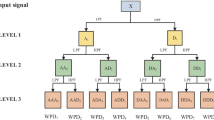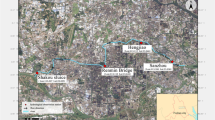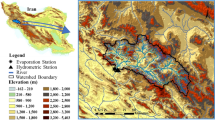Abstract
Discharge prediction with novel machine learning techniques are highly encouraged for its effective response in flood forecasting. This study establishes discharge forecasting models based on artificial neural networks (ANN) and long short-term memory (LSTM) networks at three hydrological stations, Teesta Bazaar, Domohani, and Mekhliganj, within the Teesta river basin, India, for different lead times. Wavelet transform was linked with ANN and LSTM to develop two hybrid models: the wavelet-based artificial neural network (WANN) and the wavelet-based long short-term memory (WLSTM) models. The selection of input variables for the WANN model was carried out through cross-correlation statistics of the discharge data from 2001 to 2017, available only for the monsoon season. Wavelet decomposition of the discharge data culminated in various details and approximation components, which were arranged in specific combinations to generate multiple sub-series. These sub-series were employed to formulate the WANN and WLSTM models. Both LSTM and WLSTM models applied Encoder-Decoder-LSTM (En-De-LSTM) architecture for those stations with multivariate inputs. Furthermore, the Coefficient of Determination (R2), Nash–Sutcliffe Efficiency (NSE), Root Mean Square Error (RMSE), and Mean Absolute Error (MAE) have been utilized to assess the accuracy of WANN, LSTM, and WLSTM models and compare them. The LSTM networks are characterized by long-term dependencies, memorizing the necessary information, and discarding redundant data. This research highlights that WANN and WLSTM models are superior alternatives for long-term discharge prediction, which can assist the strategy makers in mitigating flood.










Similar content being viewed by others
Data availability
The data is not allowed to disclose.
Code availability
The authors are not willing to disclose the codes used in this study.
References
Abbaszadeh Shahri A, Shan C, Larsson S (2022) A novel approach to uncertainty quantification in groundwater table modeling by automated predictive deep learning. Nat Resour Res 31:1351–1373. https://doi.org/10.1007/s11053-022-10051-w
Adamowski J, Chan HF (2011) A wavelet neural network conjunction model for groundwater level forecasting. J Hydrol 407:28–40. https://doi.org/10.1016/j.jhydrol.2011.06.013
Aksoy H, Guven A, Aytek A et al (2007) Discussion of “generalized regression neural networks for evapotranspiration modelling.” Hydrol Sci J 52:825–831
Alp M, Cigizoglu HK (2007) Suspended sediment load simulation by two artificial neural network methods using hydrometeorological data. Environ Model Softw 22:2–13. https://doi.org/10.1016/j.envsoft.2005.09.009
Anctil F, Tape DG (2004) An exploration of artificial neural network rainfall-runoff forecasting combined with wavelet decomposition. J Environ Eng Sci 3:S121–S128. https://doi.org/10.1139/s03-071
Aqil M, Kita I, Yano A, Nishiyama S (2007) A comparative study of artificial neural networks and neuro-fuzzy in continuous modeling of the daily and hourly behaviour of runoff. J Hydrol 337:22–34. https://doi.org/10.1016/j.jhydrol.2007.01.013
Badrzadeh H, Sarukkalige R, Jayawardena AW (2013) Impact of multi-resolution analysis of artificial intelligence models inputs on multi-step ahead river flow forecasting. J Hydrol 507:75–85. https://doi.org/10.1016/j.jhydrol.2013.10.017
Chakraborty S, Biswas S (2021) Simulation of flow at an ungauged river site based on HEC-HMS model for a mountainous river basin. Arab J Geosci 14:1–17. https://doi.org/10.1007/s12517-021-08385-5
Chau KW, Wu CL, Li YS (2005) Comparison of several flood forecasting models in Yangtze River. J Hydrol Eng ASCE 10:485–491
Cheng M, Fang F, Kinouchi T et al (2020) Long lead-time daily and monthly streamflow forecasting using machine learning methods. J Hydrol. https://doi.org/10.1016/j.jhydrol.2020.125376
Daubechies I (1990) The Wavelet Transform, time-frequency localization and signal analysis. IEEE Trans Inf Theory 36:6–7
Fathian F, Mehdizadeh S, Kozekalani Sales A, Safari MJS (2019) Hybrid models to improve the monthly river flow prediction: Integrating artificial intelligence and non-linear time series models. J Hydrol 575:1200–1213. https://doi.org/10.1016/j.jhydrol.2019.06.025
Gardenfors P, Sahlin NE (1982) Unreliable probabilities, risk taking, and decision making. Synthese 53:361–386
Goyal MK, Goswami UP (2018) Teesta River and its ecosystem. In: Singh D (ed) The Indian rivers. Springer Hydrogeology. Springer, Singapore, pp 537–551
Grossman A, Morlet J (1984) Decomposition of hardy function into square integrable wavelets of constant shape. SIAM J Math Anal 15:723–736
Guo J, Zhou J, Qin H et al (2011) Monthly streamflow forecasting based on improved support vector machine model. Expert Syst Appl 38:13073–13081. https://doi.org/10.1016/j.eswa.2011.04.114
Han H, Morrison RR (2021) Data-driven approaches for runoff prediction using distributed data. Stoch Environ Res Risk Assess. https://doi.org/10.1007/s00477-021-01993-3
He Z, Wen X, Liu H, Du J (2014) A comparative study of artificial neural network, adaptive neuro fuzzy inference system and support vector machine for forecasting river flow in the semiarid mountain region. J Hydrol 509:379–386. https://doi.org/10.1016/j.jhydrol.2013.11.054
He X, Guan H, Qin J (2015) A hybrid wavelet neural network model with mutual information and particle swarm optimization for forecasting monthly rainfall. J Hydrol 527:88–100. https://doi.org/10.1016/j.jhydrol.2015.04.047
Hochreiter S, Schmidhuber J (1997) Long short-term memory. Neural Comput 9:1735–1780
Kalra A, Ahmad S, Nayak A (2013) Increasing streamflow forecast lead time for snowmelt-driven catchment based on large-scale climate patterns. Adv Water Resour 53:150–162. https://doi.org/10.1016/j.advwatres.2012.11.003
Kasiviswanathan KS, He J, Sudheer KP, Tay JH (2016) Potential application of wavelet neural network ensemble to forecast streamflow for flood management. J Hydrol 536:161–173. https://doi.org/10.1016/j.jhydrol.2016.02.044
Kennedy MC, O’Hagan A (2001) Bayesian calibration of computer models. J R Stat Soc Ser B Stat Methodol 63:425–464. https://doi.org/10.1111/1467-9868.00294
Kim T-W, Valdé JB (2003) Nonlinear model for drought forecasting based on a conjunction of wavelet transforms and neural networks. J Hydrol Eng 8:319–328. https://doi.org/10.1061/ASCE1084-069920038:6319
Kişi Ö (2009) Neural networks and wavelet conjunction model for intermittent streamflow forecasting. J Hydrol Eng 14:773–782. https://doi.org/10.1061/ASCEHE.1943-5584.0000053
Kisi O, Shiri J, Nikoofar B (2012) Forecasting daily lake levels using artificial intelligence approaches. Comput Geosci 41:169–180. https://doi.org/10.1016/j.cageo.2011.08.027
Koutsoyiannis D (2007) Discussion of “generalized regression neural networks for evapotranspiration modelling.” Hydrol Sci J 52:832–839
Kratzert F, Klotz D, Brenner C et al (2018) Rainfall-runoff modelling using long short-term memory (LSTM) networks. Hydrol Earth Syst Sci 22:6005–6022. https://doi.org/10.5194/hess-22-6005-2018
Le XH, Ho HV, Lee G, Jung S (2019) Application of long short-term memory (LSTM) neural network for flood forecasting. Water (Switzerland) 11. https://doi.org/10.3390/w11071387
Liu Z, Zhou P, Chen X, Guan Y (2015) A multivariate conditional model for streamflow prediction and spatial precipitation refinement. J Geophys Res 120:10116–10129. https://doi.org/10.1002/2015JD023787
Liu K, Yao C, Chen J et al (2017) Comparison of three updating models for real time forecasting: a case study of flood forecasting at the middle reaches of the Huai River in East China. Stoch Environ Res Risk Assess 31:1471–1484. https://doi.org/10.1007/s00477-016-1267-x
Liu D, Jiang W, Mu L, Wang S (2020) Streamflow prediction using deep learning neural network: case study of Yangtze River. IEEE Access 8:90069–90086. https://doi.org/10.1109/ACCESS.2020.2993874
Maier HR, Jain A, Dandy GC, Sudheer KP (2010) Methods used for the development of neural networks for the prediction of water resource variables in river systems: current status and future directions. Environ Model Softw 25:891–909
Mallat SG (1989) A theory for multiresolution signal decomposition: the wavelet representation. IEEE Trans Pattern Anal Mach Intell 11(7):674–693
Mehedi MAA, Khosravi M, Yazdan MMS, Shabanian H (2022) Exploring temporal dynamics of river discharge using univariate long short-term memory (LSTM) recurrent neural network at East Branch of Delaware River. Hydrology 9:202. https://doi.org/10.3390/hydrology9110202
Moriasi DN, Arnold JG, Van LMW et al (2007) Model evaluation guidelines for systematic quantification of accuracy in watershed simulations. Trans ASABE 50:885–900
Mouatadid S, Adamowski JF, Tiwari MK, Quilty JM (2019) Coupling the maximum overlap discrete wavelet transform and long short-term memory networks for irrigation flow forecasting. Agric Water Manag 219:72–85. https://doi.org/10.1016/j.agwat.2019.03.045
Nalley D, Adamowski J, Khalil B (2012) Using discrete wavelet transforms to analyze trends in streamflow and precipitation in Quebec and Ontario (1954–2008). J Hydrol 475:204–228. https://doi.org/10.1016/j.jhydrol.2012.09.049
Nash JE, Sutcliffe JV (1970) River flow forecasting through conceptual models - Part I - A discussion of principles. J Hydrol 10:282–290
Nayak PC, Sudheer KP, Rangan DM, Ramasastri KS (2005) Short-term flood forecasting with a neurofuzzy model. Water Resour Res 41:1–16. https://doi.org/10.1029/2004WR003562
Nayak PC, Venkatesh B, Krishna B, Jain SK (2013) Rainfall-runoff modeling using conceptual, data driven, and wavelet based computing approach. J Hydrol 493:57–67. https://doi.org/10.1016/j.jhydrol.2013.04.016
Ni L, Wang D, Singh VP et al (2020) Streamflow and rainfall forecasting by two long short-term memory-based models. J Hydrol. https://doi.org/10.1016/j.jhydrol.2019.124296
Nourani V, Komasi M (2013) A geomorphology-based ANFIS model for multi-station modeling of rainfall-runoff process. J Hydrol 490:41–55. https://doi.org/10.1016/j.jhydrol.2013.03.024
Nourani V, Alami MT, Aminfar MH (2008) A combined neural-wavelet model for prediction of Ligvanchai watershed precipitation. Eng Appl Artif Intell 22:466–472. https://doi.org/10.1016/j.engappai.2008.09.003
Nourani V, Komasi M, Mano A (2009) A multivariate ANN-wavelet approach for rainfall-runoff modeling. Water Resour Manag 23:2877–2894. https://doi.org/10.1007/s11269-009-9414-5
Nourani V, Hosseini Baghanam A, Adamowski J, Kisi O (2014) Applications of hybrid wavelet-artificial intelligence models in hydrology: a review. J Hydrol 514:358–377
Olah C (2015) Understanding LSTM networks. https://colah.github.io/posts/2015-08-Understanding-LSTMs/ Accessed16 Nov 2021
Partal T, Cigizoglu HK (2008) Estimation and forecasting of daily suspended sediment data using wavelet-neural networks. J Hydrol 358:317–331. https://doi.org/10.1016/j.jhydrol.2008.06.013
Partal T, Küçük M (2006) Long-term trend analysis using discrete wavelet components of annual precipitations measurements in Marmara region (Turkey). Phys Chem Earth 31:1189–1200. https://doi.org/10.1016/j.pce.2006.04.043
Ravansalar M, Rajaee T, Kisi O (2017) Wavelet-linear genetic programming: a new approach for modeling monthly streamflow. J Hydrol 549:461–475. https://doi.org/10.1016/j.jhydrol.2017.04.018
Rumelhart DE, Hinton GE, Williams RJ (1986) Learning internal representations by error propagation. In: Parallel distributed processing: explorations in the microstructure of cognition
Sang YF, Wang Z, Liu C (2015) Wavelet neural modeling for hydrologic time series forecasting with uncertainty evaluation. Water Resour Manag 29:1789–1801. https://doi.org/10.1007/s11269-014-0911-9
Shortridge JE, Guikema SD, Zaitchik BF (2016) Machine learning methods for empirical streamflow simulation: a comparison of model accuracy, interpretability, and uncertainty in seasonal watersheds. Hydrol Earth Syst Sci 20:2611–2628. https://doi.org/10.5194/hess-20-2611-2016
Sudheer KP, Gosain AK, Ramasastri KS (2002) A data-driven algorithm for constructing artificial neural network rainfall-runoff models. Hydrol Process 16:1325–1330. https://doi.org/10.1002/hyp.554
Sun AY, Wang D, Xu X (2014) Monthly streamflow forecasting using Gaussian process regression. J Hydrol 511:72–81. https://doi.org/10.1016/j.jhydrol.2014.01.023
Sun Y, Niu J, Sivakumar B (2019) A comparative study of models for short-term streamflow forecasting with emphasis on wavelet-based approach. Stoch Environ Res Risk Assess 33:1875–1891. https://doi.org/10.1007/s00477-019-01734-7
Tiwari MK, Chatterjee C (2010) Development of an accurate and reliable hourly flood forecasting model using wavelet-bootstrap-ANN (WBANN) hybrid approach. J Hydrol 394:458–470. https://doi.org/10.1016/j.jhydrol.2010.10.001
Venkata Ramana R, Krishna B, Kumar SR, Pandey NG (2013) Monthly rainfall prediction using wavelet neural network analysis. Water Resour Manag 27:3697–3711. https://doi.org/10.1007/s11269-013-0374-4
Wang W, Ding J (2003) Wavelet network model and its application to the prediction of hydrology. Nat Sci 1(1):67–71
Wang K, Band SS, Ameri R et al (2022) Performance improvement of machine learning models via wavelet theory in estimating monthly river streamflow. Eng Appl Comput Fluid Mech 16:1833–1848. https://doi.org/10.1080/19942060.2022.2119281
Wu CL, Chau KW, Li YS (2009) Predicting monthly streamflow using data-driven models coupled with data-preprocessing techniques. Water Resour Res. https://doi.org/10.1029/2007WR006737
Xingang D, Ping W, Jifan C (2003) Multiscale characteristics of the rainy season rainfall and interdecadal decaying of summer monsoon in North China. Chinese Sci Bull 48:2730–2734. https://doi.org/10.1360/03wd0199
Yadav A, Chatterjee S, Equeenuddin SM (2018) Prediction of suspended sediment yield by artificial neural network and traditional mathematical model in Mahanadi river basin, India. Sustain Water Resour Manag 4:745–759. https://doi.org/10.1007/s40899-017-0160-1
Yadav A, Hasan MK, Joshi D et al (2022) Optimized scenario for estimating suspended sediment yield using an artificial neural network coupled with a genetic algorithm. Water (switzerland) 14:1–22. https://doi.org/10.3390/w14182815
Yan H, Ma T (2014) A group decision-making approach to uncertain quality function deployment based on fuzzy preference relation and fuzzy majority. Eur J Oper Res. https://doi.org/10.1016/j.ejor.2014.09.017
Yin Z, Feng Q, Wen X et al (2018) Design and evaluation of SVR, MARS and M5Tree models for 1, 2 and 3-day lead time forecasting of river flow data in a semiarid mountainous catchment. Stoch Environ Res Risk Assess 32:2457–2476. https://doi.org/10.1007/s00477-018-1585-2
Yuan X, Chen C, Lei X et al (2018) Monthly runoff forecasting based on LSTM–ALO model. Stoch Environ Res Risk Assess 32:2199–2212. https://doi.org/10.1007/s00477-018-1560-y
Zhang X, Peng Y, Zhang C, Wang B (2015) Are hybrid models integrated with data preprocessing techniques suitable for monthly streamflow forecasting? Some experiment evidences. J Hydrol 530:137–152. https://doi.org/10.1016/j.jhydrol.2015.09.047
Zhang H, Singh VP, Wang B, Yu Y (2016) CEREF: A hybrid data-driven model for forecasting annual streamflow from a socio-hydrological system. J Hydrol 540:246–256. https://doi.org/10.1016/j.jhydrol.2016.06.029
Zhu S, Luo X, Yuan X, Xu Z (2020) An improved long short-term memory network for streamflow forecasting in the upper Yangtze River. Stoch Environ Res Risk Assess 34:1313–1329. https://doi.org/10.1007/s00477-020-01766-4
Funding
The authors declare that no funding was received for conducting this study.
Author information
Authors and Affiliations
Contributions
SC conceived the problem, collected the data, prepared the methodology, conducted the formal analysis, and written the original draft. SB contributed in collecting data, editing the manuscript and supervision.
Corresponding author
Ethics declarations
Competing interests
The authors declare no competing interests.
Ethics approval
Not applicable.
Consent to participate
The authors express their consent to participate in research and review.
Consent for publication
The authors express their consent for publication of research work.
Additional information
Publisher's Note
Springer Nature remains neutral with regard to jurisdictional claims in published maps and institutional affiliations.
Rights and permissions
Springer Nature or its licensor (e.g. a society or other partner) holds exclusive rights to this article under a publishing agreement with the author(s) or other rightsholder(s); author self-archiving of the accepted manuscript version of this article is solely governed by the terms of such publishing agreement and applicable law.
About this article
Cite this article
Chakraborty, S., Biswas, S. River discharge prediction using wavelet-based artificial neural network and long short-term memory models: a case study of Teesta River Basin, India. Stoch Environ Res Risk Assess 37, 3163–3184 (2023). https://doi.org/10.1007/s00477-023-02443-y
Accepted:
Published:
Issue Date:
DOI: https://doi.org/10.1007/s00477-023-02443-y




